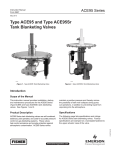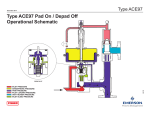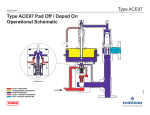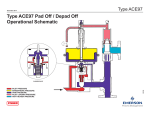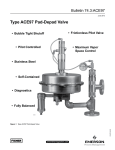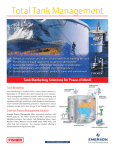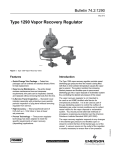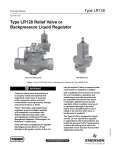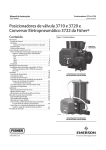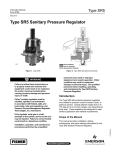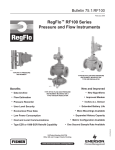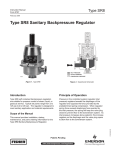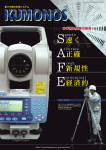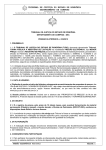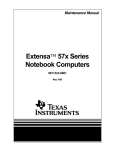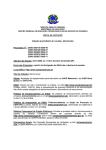Download Emerson ACE97 Instruction Manual
Transcript
Type ACE97 Instruction Manual Form 5665 November 2011 Type ACE97 Pad-Depad Valve DEPAD PILOT VALVE DEPAD MAIN VALVE W8161 VENT ACTUATOR GAS INLET PAD VALVE TO TANK Figure 1. Type ACE97 Pad-Depad Valve (NPS 1/2 / DN 15 Pad Valve / 1 NPT Depad Valve Shown) ! WARNING Fisher® pad-depad valves must be installed, operated, and maintained in accordance with federal, state, and local codes, rules and regulations, and Emerson Process Management Regulator Technologies, Inc. (Regulator Technologies) instructions. D102773X012 Failure to follow these instructions or to properly install and maintain this equipment could result in an explosion, fire and/or chemical contamination causing property damage and personal injury or death. www.fisherregulators.com Type ACE97 Specifications Ratings and specifications for the Type ACE97 Pad-Depad valve are listed in the Specifications section below. Factory specifications are stamped on the nameplate fastened to the actuator of the valve. Pad (Tank Blanketing) Specifications Pad Body Sizes and End Connection Styles 1/2, 1, and 2 NPT NPS 1/2, 1, and 2 / DN 15, 25, and 50 CL150 RF Maximum Operating Inlet Pressure(1) 200 psig / 13,8 bar Maximum Main Valve Inlet Pressure(1) 200 psig / 13,8 bar Inlet Operating Ranges(1) NPS 1/2 / DN 15 pad valve: 25 to 200 psig / 1,7 to 13,8 bar NPS 1 and 2 / DN 25 and 50 pad valves: 25 to 50 psig / 1,7 to 3,4 bar 51 to 120 psig / 3,5 to 8,2 bar 121 to 200 psig / 8,3 to 13,8 bar Control Pressure Ranges(1) See Table 1 Maximum and Minimum Differential Pressures(1) 25 psig / 1,7 bar minimum 200 psig / 13,8 bar maximum Maximum Backpressure(1) 20 psig (1,4 bar) Flow Coefficients for Relief Valve Sizing (110% of rated Cv) NPS 1/2 / DN 15: Cv 0.2 use Cv 0.22 Cv 0.4 use Cv 0.44 NPS 1 / DN 25: Cv 1 use Cv 1.1 Cv 2 use Cv 2.2 Cv 4 use Cv 4.4 Cv 7.5 use Cv 8.25 Cv 10 use Cv 11 NPS 2 / DN 50: Cv 20 use Cv 22 Cv 45 use Cv 50 Cv 60 use Cv 66 Depad (Vapor Recovery) Specifications Depad Body Sizes 1 and 2 NPT NPS 3 and 4 / DN 80 and 100 Depad Pressure Ranges(1) See Table 1 Valve Coefficients (110% of rated Cv) 1 NPT: Cv 3 use Cv 3.3 Cv 6 use Cv 7 Cv 12 use Cv 13 Cv 17 use Cv 19 2 NPT: Cv 20 use Cv 22 Cv 35 use Cv 39 Cv 70 use Cv 77 NPS 3 / DN 80: Cv 90 use Cv 99 Cv 115 use Cv 127 Cv 140 use Cv 154 NPS 4 / DN 100: Cv 150 use Cv 165 Cv 200 use Cv 220 Cv 280 use Cv 308 General Type ACE97 Specifications Pressure Registration External Temperature Capabilities Nitrile (NBR): -20° to 180°F / -29° to 82°C Fluorocarbon (FKM): 0° to 212°F / -18° to 100°C Ethylenepropylene (EPDM - FDA): -20° to 212°F / -29° to 100°C Perfluoroelastomer (FFKM): -20° to 212°F / -29° to 100°C Approximate Weights NPS 1/2 x 1 x 1 / DN 15 x 25 x 25: 70 pounds / 32 kg NPS 1 x 2 x 2 / DN 25 x 50 x 50: 105 pounds / 48 kg NPS 2 x 3 x 3 / DN 50 x 80 x 80: 175 pounds / 79 kg 1. The pressure/temperature limits in this Instruction Manual or any applicable standard limitation should not be exceeded. 2 Type ACE97 LOADING PRESSURE EXHAUSTED BACK TO TANK ON/OFF DIAGNOSTIC GAUGE DEPAD PILOT ADJUSTABLE DEADBAND REGULATOR CONTROLLED PRESSURE RANGE SPRING E POPPET CAGE VENT O-RING SEAT ACTUATOR INLET BLEED INLET RESSURE PRESSURE PHERIC PRESSURE G PRESSURE EDIATE PRESSURE UPPLY PRESSURE EDIATE BLEED PRESSURE PANSION PRESSURE M PRESSURE RESSURE S PRESSURE E0005 RESSURE RESSURE PRESSURE ST OADING PRESSURE EADER PRESSURE LEED PRESSURE DEPAD MAIN VALVE ROLLING DIAPHRAGM SENSING CONNECTION DIAGNOSTIC PORT MAIN VALVE SPRING OPEN PILOT INLET PRESSURE ATMOSPHERIC PRESSURE TANK PRESSURE PILOT LOADING PRESSURE INERT GAS IN TANK CONNECTION PAD VALVE VENT HEADER PRESSURE INLET BLEED PRESSURE Figure 2. Type ACE97 Pad On / Depad Off Table 1. Actuator Spring Pressure Ranges CONTROL PRESSURE RANGES Pad Setpoint inches w.c. SPRING FREE LENGTH Depad Setpoint (Above Pad) INCHES mm INCHES mm 10 to 25 3.08 78,2 0.105 2,67 10 to 15 4.0 102 0.092 2,34 4 to 16 10 to 40 3.73 94,7 0.156 3,96 16 to 78 40 to 194 3.73 2.90 94,7 73,7 0.156 0.250 3,96 6,35 mbar inches w.c. mbar 0.5 to 3- 1 to 7 4 to 10 0.5 to 7 1 to 17 4 to 6 3 to 13 7 to 32 4 to 10 10 to 25 (1) SPRING WIRE DIAMETER (1) 0.5 to 1.4 psig 34 to 97 mbar 0.25 to 1 psig 17 to 69 3.8 96,5 0.250 6,35 1.0 to 2.2 psig 69 to 152 mbar 0.25 to 2 psig 17 to 138 3.8 96,5 0.313 7,95 1. Two nested springs are used (See Figure 12). If a leak develops or if the unit or outlet continually vents gas, service to the unit may be required. Failure to correct trouble could result in a hazardous condition. Only a qualified person must install or service the unit. Installation, operation, and maintenance procedures performed by unqualified personnel may result in improper adjustment and unsafe operation. Either condition may result in equipment damage or personal injury. Use qualified personnel when installing, operating, and maintaining the Type ACE97 pad-depad valve. Introduction Scope of the Manual This instruction manual provides installation, startup, maintenance, and parts ordering information for the Type ACE97 Pad-Depad valve (Figure 1). The product photo may vary depending on the size of the valve ordered. 3 Type ACE97 LOADING PRESSURE EXHAUSTED BACK TO TANK URE SSURE C PRESSURE SSURE E PRESSURE Y PRESSURE E BLEED PRESSURE ON PRESSURE SSURE URE SSURE URE URE SURE DEPAD PILOT CONTROLLED PRESSURE RANGE SPRING REGULATOR NG PRESSURE R PRESSURE PRESSURE RE ON/OFF DIAGNOSTIC GAUGE DEPAD MAIN VALVE Vent POPPET VENT ACTUATOR CAGE O-RING SEAT INLET ROLLING DIAPHRAGM SENSING CONNECTION CLOSED PILOT DIAGNOSTIC PORT MAIN VALVE SPRING E0004 INLET PRESSURE ATMOSPHERIC PRESSURE TANK PRESSURE INERT GAS IN PAD VALVE TANK CONNECTION PILOT LOADING PRESSURE VENT HEADER PRESSURE Figure 3. Type ACE97 Pad Off / Depad On Product Description Principle of Operation The Type ACE97 Pad-Depad valve is a self-contained, pilot-operated valve that maintains a blanket of inert gas on top of a stored product to protect it from atmospheric contamination. It reduces combustibility, decreases vaporization, controls vapor space pressure during pump-in and pump-out operations, and prevents the tank from entering a vacuum condition and collapsing upon itself. The Type ACE97 valve provides excellent and accurate pressure control of the vapor space in the tank. Blanketing pressure is kept to a minimum in order to conserve the use of blanketing gas. Type ACE97 pilot-operated valves (except for the NPS 1/2 / DN 15 pad valve) control the vapor space pressure over a stored liquid. The unit is stainless steel and is controlled by a very large actuator diaphragm. The oversized actuator diaphragm offers high sensitivity to changes in tank pressure. When a storage tank cools and tank vapors condense, Type ACE97 pad (tank blanketing) valves replace the condensing vapors with an inert gas to prevent internal tank pressure from decreasing. Positive tank pressure prevents outside air from contaminating the product and reduces the possibility of atmospheric pressure collapsing the tank. Pad (tank blanketing) is used to describe the process of replacing the vapor space of a storage tank with an inert gas. Depad (vapor recovery) is used to describe the process of relieving or venting the vapor space as a result of pressure rise. Tank and vapor recovery connections are available to meet most customer requirements. A Single Array Manifold (S.A.M) provides a single tank and sensing connection and is required for tanks having a single nozzle. Accessories include gauges, purge meters, pressure switches, and check valves. 4 Additionally, Type ACE97 valves provide depad (vapor recovery) capabilities through the depad main valve and depad pilot valve. When the temperature outside the tank rises causing the vapor inside the tank to expand, Type ACE97 depad valve vents the excess tank pressure to a safe place. Type ACE97 PRESSURE ET PRESSURE SPHERIC PRESSURE NG PRESSURE MEDIATE PRESSURE SUPPLY PRESSURE MEDIATE BLEED PRESSURE XPANSION PRESSURE UM PRESSURE PRESSURE SS PRESSURE PRESSURE PRESSURE T PRESSURE UST LOADING PRESSURE HEADER PRESSURE BLEED PRESSURE LOADING PRESSURE EXHAUSTED BACK TO TANK DEPAD PILOT ADJUSTABLE DEADBAND POPPET CAGE INLET DEPAD MAIN VALVE VENT O-RING SEAT ACTUATOR ROLLING DIAPHRAGM SENSING CONNECTION SSURE SSURE E SSURE SSURE ED PRESSURE ESSURE E CONTROLLED PRESSURE RANGE SPRING REGULATOR ON/OFF DIAGNOSTIC GAUGE CLOSED PILOT DIAGNOSTIC PORT MAIN VALVE SPRING E0006 INLET PRESSURE ATMOSPHERIC PRESSURE TANK PRESSURE INERT GAS IN PAD VALVE TANK CONNECTION PILOT LOADING PRESSURE VENT HEADER PRESSURE Figure 4. Type ACE97 Pad Off / Depad Off NPS 1 and 2 / DN 25 and 50 Pad Valves (Figure 2) When tank pressure decreases below the pad setpoint (due to pump-out operations or thermal cooling), the actuator diaphragm moves downward pushing open the pad pilot. This creates flow from the pad loading chamber to downstream. When pad loading pressure decreases, the force created by inlet pressure on the pad main valve plug overcomes the main spring force and opens the main valve plug allowing flow through the pad valve to the tank. Once tank pressure reaches pad setpoint, the pad pilot closes, pad loading pressure equalizes with inlet pressure and the pad valve closes. NPS 1/2 / DN 15 Pad Valve (Not Shown) The NPS 1/2 / DN 15 pad valve has a main valve only. When tank pressure decreases below the pad setpoint the actuator diaphragm moves downward pushing the valve plug open and allowing flow through the pad valve to the tank. Depad (Figure 3) When tank pressure increases above the depad setpoint (due to pump-in operations or thermal heating), the actuator diaphragm moves upward and pushes open the depad pilot. This releases depad loading pressure (nitrogen or other supply gas). When depad pilot loading pressure decreases, the depad main valve opens by a spring and allows flow from the tank to the vent or recovery system. The blanketing (padding) gas is used as the pilot fluid. The link between the actuator and the depad main valve is provided by the depad pilot valve, which is located on top of the actuator. The depad pilot valve is connected to the actuator by an adjustable coupling, which can be rotated to adjust the depad setpoint. A locknut is provided on the depad pilot valve to secure the setpoint adjustment. 5 Type ACE97 DEPAD DIAGNOSTIC GAUGE TANK VAPOR SPACE PRESSURE GAUGE VENT CONNECTION PAD DIAGNOSTIC GAUGE SENSING CONNECTION INLET PRESSURE GAUGE INLET VALVE SENSING LINE BLANKETING GAS SUPPLY LINE LINE STRAINER VALVE TANK CONNECTION BLANKETING GAS CONNECTION SHUTOFF VALVE TANK VALVE EMERGENCY TANK VENT NORMAL TANK VENT VAPOR SPACE LIQUID E0629 Figure 5. Type ACE97 Pad-Depad Valve Installation Installation and Startup ! WARNING Personal injury, equipment damage, or leakage due to escaping accumulated gas or bursting of pressure-containing parts may result if this gas blanketing system is overpressured or installed where service conditions could exceed the limits given in the Specifications section or on the valve nameplate, or where conditions exceed any ratings of the adjacent piping, piping connections, or compatibility of valve materials with process fluids. To avoid such injury or damage, provide pressure-relieving or pressure-limiting devices (as required by Title 49, Part 192, of the U.S. Code of Federal Regulations, by the National Fuel Gas Code Title 54 of the National Fire Codes of the National Fire Protection Agency, or by other applicable codes) to prevent service conditions from exceeding those limits. 6 Additionally, physical damage to the tank blanketing system could result in personal injury and property damage due to escaping gas or tank contents. To avoid such injury and damage, install the tank blanketing valve in a safe location. The Type ACE97 Pad-Depad valve is assembled and preset to the customer specified pressure and setpoint. The pressure ranges of the valve are stamped on the nameplate attached to the upper actuator case. 1. Use qualified personnel when installing, operating, and maintaining valves. Before installing, inspect the main valve, pilot, and tubing for any shipment damage or foreign material that may have collected. Ensure that the body interior is clean and the pipelines are free of foreign material. Apply pipe compound only to the external pipe threads with a threaded body, or use suitable line gaskets and good bolting practices with a flanged body. 2. Inspect the nameplate on the upper actuator case. It displays the model number, serial number, blanketing gas supply pressure range, maximum inlet pressure, Cv value, and set pressures. These Type ACE97 must agree with the system that you are Padding (blanketing) or Depadding (recovering). The serial number will be needed in any communication with your local Sales Office. 3. Clean the gas padding (blanketing) supply lines of all dirt and foreign material before connecting them to the Type ACE97 Pad-Depad valve. 4. The valve should be mounted above the tank with the actuator case in a horizontal position. Four connections are required (see Figure 5): a. Blanketing gas supply to the valve b. Vapor recovery/process connection (vent) c. System tank connection d. Sensing line to the tank Piping Considerations Piping must be capable of supporting the weight of the system. Use pipe supports when necessary. Refer to Figure 5. Inlet Piping The padding (blanketing) gas supply line should be equipped with a Number 100 mesh strainer to remove dirt and pipe scale. Inlet piping must be sized to adequately deliver padding (blanketing) gas at the specified inlet pressure under full flow conditions. CAUTION Undersized piping may inadequately deliver Padding (blanketing) gas at the specified inlet pressure under full flow conditions. This may result in unacceptable performance under high demand conditions. Outlet Piping Valve outlet is piped into the tank vapor space. Outlet piping should be self-draining to the tank and of equal or greater size than the Type ACE97 valve tank connection. The valve should be situated above and as close as possible to the tank vapor space for best performance. CAUTION Unnecessarily long or restricted outlet piping may result in poor setpoint control. Sensing Line The sensing line should be 1/2-inch / 13 mm tubing or pipe, must slope toward the tank, and should not contain low points (or traps) that could catch liquid. The sensing line must enter the tank above the liquid level at a point that senses the vapor space pressure and is free from turbulence associated with tank nozzles or vents. Note Best control is obtained when both connections to the tank are separate. If the tank has only one available nozzle, contact Regulator Technologies for alternate methods of installation. A Single Array Manifold (S.A.M.) is available for such situations. Vent Connection The vent connection must be self-draining, facing away from the valve, and of equal or greater size than the valve tank connection. Tank Venting The tank may require normal and emergency vents. The Type ACE97 Pad-Depad valve does not perform these functions, it only controls the vapor space pressure under process conditions. Diagnostic Gauges An on/off diagnostic gauge is mounted on the depad main valve at the inlet to the cylinder. The face on the gauge is marked to indicate whether the main pad valve is opened, closed, or throttled. Shutoff Valves Note Safety considerations may dictate shutoff valves between the tank and Type ACE97 valve. Inlet (isolation) valves are desirable for servicing the Type ACE97 valve. If this valve was not ordered with an inlet pressure gauge, it is advisable to install a gauge between the inlet isolation (full-port) valve and the padding (blanketing) valve. 7 Type ACE97 ADJUSTING SCREW TUBING LOCKNUT COUPLING ACTUATOR E0679 E0678 Figure 6. Unthreading the Adjusting Coupling Startup, Adjustment, and Shutdown CAUTION If required, tank vents (normal and emergency) must be in place and operating. Figure 7. Changing the Pad Setpoint Adjustment The setpoint of this unit is factory set. If an adjustment is to be made, it should be made in small increments while the unit is controlling tank pressure. It is difficult to make field adjustments due to the slow changes in tank pressure. To change the pad (blanketing) setpoint: 1. Disconnect the tubing from the depad pilot valve (See Figure 6). Startup CAUTION Always open the tank shutoff valve prior to the inlet shutoff valve. Failure to do so could result in inlet pressure being applied to the actuator casing, potentially damaging it. Refer to Figure 5. 1. Open the tank and sensing line shutoff valves (between the Type ACE97 valve and tank). 2. A tank vapor space pressure gauge should be installed and visible. 3. Slowly open the inlet shutoff valve (to the pad valve) and leave it fully open. 4. Monitor the tank vapor space pressure. 2. Loosen the locknut (See Figure 7), but maintain its position in relation to the adjusting coupling. Doing so leaves the depad setpoint unchanged. 3. Separate the depad pilot valve from the actuator by unthreading and removing. 4. Unthread and remove the adjusting coupling. 5. Increase the pad setpoint by turning the adjusting screw clockwise. (Turning the screw counterclockwise decreases the setpoint). See Figure 7. 6. Replace the depad adjusting collar against the locknut to re-establish the depad setpoint. To change the depad setpoint: 1. Loosen the locknut below the adjusting coupling. 2. Rotate the collar to change the setpoint. (The bottom of the coupling—nearest the locknut—is left-hand threaded). 3. Tighten the locknut. 8 Type ACE97 All O-rings, gaskets, and seals should be lubricated with a good grade of general purpose lubricant and installed gently rather than forced into position. Approved lubricants, sealants, thread protectors, and adhesives are as follows: Table 2. Diagnostic Analysis Pressure Ranges DIAGNOSTIC STATUS Equal to inlet supply pressure Pilot and main valves are closed. Tank pressure is at or above set pressure. Slightly below inlet supply pressure Pilot valve supplies gas to tank. Tank pressure is just below set pressure. Well below inlet supply pressure Pilot and main valves are both supplying gas to the tank. Tank pressure is below setpoint. Lubricants: Dow Corning® #111, Dow Corning® #3452 Chemical Resistant Lubricant Thread Protector: Anti-Seize Sealant: Loctite® PST #592, Polytetrafluoroethylene (PTFE) Tape In any installation it is important to open and close valves slowly and to close the inlet shutoff valve first when shutting down the system. Adhesive: Loctite® #222 Maintenance Monthly Maintenance Valve parts are subject to normal wear and must be inspected and replaced as necessary. The frequency of inspection and replacement of parts depend on the severity of service conditions and the requirements of local, state, and federal regulations. Due to the care Regulator Technologies takes in meeting all manufacturing requirements, use only replacement parts manufactured or furnished by Regulator Technologies. 1. Visually inspect the unit to ensure tight connections, tight seals, and safe operation. Shutdown Be certain that nameplates are updated to accurately indicate any field changes in equipment, materials, service conditions, or pressure settings. 2. Observe the pad and depad (tank blanketing and vapor recovery) pressures. 3. Inspect the inlet pressure for the proper range (stamped on the valve nameplate). Table 3. Diagnostics Table: Cv 1 through 4, Inlet Pressure Range Spring 25 to 50 psig / 1,7 to 3,4 bar ACTUAL INLET SUPPLY PRESSURE TO VALVE psig DIAGNOSTIC PORT PRESSURE Pressure when Pilot Starts to Open bar psig bar 25 1,7 24 1,7 30 2,1 29 2,0 35 2,4 34 2,3 40 2,8 39 45 3,1 44 50 3,4 49 Pressure when Main Valve Starts to Open Pressure when Main Valve is Fully Open psig bar psig bar 9 0,62 2 0,14 13 0,90 6 0,41 16 1,1 9 0,62 2,7 20 1,4 13 0,90 3,0 24 1,7 17 1,2 3,4 28 1,9 21 1,4 Table 4. Diagnostics Table: Cv 1 through 4, Inlet Pressure Range Spring 51 to 120 psig / 3,5 to 8,3 bar ACTUAL INLET SUPPLY PRESSURE TO VALVE DIAGNOSTIC PORT PRESSURE Pressure when Pilot Starts to Open Pressure when Main Valve Starts to Open Pressure when Main Valve is Fully Open psig bar psig bar psig bar psig bar 51 3,5 50 3,4 29 2,0 5 0,35 60 4,1 59 4,1 36 2,5 12 0,83 70 4,8 69 4,8 43 3,0 19 1,3 80 5,5 79 5,4 51 3,5 27 1,9 90 6,2 89 6,1 59 4,1 34 2,3 100 6,9 99 6,8 66 4,5 42 2,9 110 7,6 109 7,5 74 5,1 50 3,4 120 8,3 119 8,2 81 5,6 57 3,9 9 Type ACE97 Table 5. Diagnostics Table: Cv 1 through 4, Inlet Pressure Range Spring 121 to 200 psig / 8,3 to 13,8 bar ACTUAL INLET SUPPLY PRESSURE TO VALVE DIAGNOSTIC PORT PRESSURE Pressure when Pilot Starts to Open Pressure when Main Valve Starts to Open Pressure when Main Valve is Fully Open psig bar psig bar psig bar psig bar 121 8,3 120 8,3 74 5,1 30 2,1 130 9,0 129 8,9 81 5,6 37 2,5 140 9,6 139 9,6 88 6,1 45 3,1 150 10,3 149 10,3 96 6,6 53 3,6 160 11,0 159 10,9 104 7,2 60 4,1 170 11,7 169 11,7 111 7,6 68 4,7 180 12,4 179 12,3 119 8,2 75 5,2 190 13,1 189 13,0 127 8,8 83 5,7 200 13,8 199 13,7 134 9,2 91 6,3 Table 6. Diagnostics Table: Cv 7.5 through 10, Inlet Pressure Range Spring 25 to 50 psig / 1,7 to 3,4 bar ACTUAL INLET SUPPLY PRESSURE TO VALVE DIAGNOSTIC PORT PRESSURE Pressure when Pilot Starts to Open Pressure when Main Valve Starts to Open Pressure when Main Valve is Fully Open psig bar psig bar psig bar psig bar 25 1,7 24 1,7 11 0,76 0 0,00 30 2,1 29 2,0 14 0,96 3 0,21 35 2,4 34 2,3 17 1,2 6 0,41 40 2,8 39 2,7 21 1,4 9 0,62 45 3,1 44 3,0 24 1,7 13 0,89 50 3,4 49 3,4 27 1,9 16 1,1 Table 7. Diagnostics Table: Cv 7.5 through 10, Inlet Pressure Range Spring 51 to 120 psig / 3,5 to 8,3 bar ACTUAL INLET SUPPLY PRESSURE TO VALVE DIAGNOSTIC PORT PRESSURE Pressure when Pilot Starts to Open Pressure when Main Valve Starts to Open Pressure when Main Valve is Fully Open psig bar psig bar psig bar psig bar 51 3,5 50 3,4 24 1,7 3 0,21 60 4,1 59 4,1 30 2,1 9 0,62 70 4,8 69 4,8 36 2,5 15 1,0 80 5,5 79 5,4 42 2,9 22 1,5 90 6,2 89 6,1 49 3,4 28 1,9 100 6,9 99 6,8 55 3,8 34 2,3 110 7,6 109 7,5 61 4,2 41 2,8 120 8,3 119 8,2 68 4,7 47 3,2 Table 8. Diagnostics Table: Cv 7.5 through 10, Inlet Pressure Range Spring 121 to 200 psig / 8,3 to 13,8 bar ACTUAL INLET SUPPLY PRESSURE TO VALVE 10 DIAGNOSTIC PORT PRESSURE Pressure when Pilot Starts to Open Pressure when Main Valve Starts to Open Pressure when Main Valve is Fully Open psig bar psig bar psig bar psig bar 121 8,3 120 8,3 63 4,3 31 2,1 130 9,0 129 9,0 69 4,8 37 2,5 140 9,6 139 9,6 75 5,2 43 3,0 150 10,3 149 10,3 82 5,6 49 3,4 160 11,0 159 10,9 88 6,1 56 3,9 170 11,7 169 11,7 94 6,9 62 4,3 180 12,4 179 12,3 101 7,0 68 4,7 190 13,1 189 13,0 107 7,4 75 5,2 200 13,8 199 13,7 113 7,8 81 5,6 Type ACE97 Table 9. Diagnostics Table: Cv 20 through 60, Inlet Pressure Range Spring 25 to 50 psig / 1,7 to 3,4 bar ACTUAL INLET SUPPLY PRESSURE TO VALVE DIAGNOSTIC PORT PRESSURE Pressure when Pilot Starts to Open Pressure when Main Valve Starts to Open Pressure when Main Valve is Fully Open psig bar psig bar psig bar psig bar 25 1,7 24 1,7 16 1,1 5 0,21 30 2,1 29 2,0 20 1,4 9 0,62 35 2,4 34 2,3 24 1,6 14 0,96 40 2,8 39 2,7 29 2,0 18 1,2 45 3,1 44 3,0 33 2,2 23 1,6 50 3,4 49 3,4 38 2,6 27 1,9 Table 10. Diagnostics Table: Cv 20 through 60, Inlet Pressure Range Spring 51 to 120 psig / 3,5 to 8,3 bar ACTUAL INLET SUPPLY PRESSURE TO VALVE DIAGNOSTIC PORT PRESSURE Pressure when Pilot Starts to Open Pressure when Main Valve Starts to Open Pressure when Main Valve is Fully Open psig bar psig bar psig bar psig bar 51 3,5 50 3,4 39 2,7 11 0,76 60 4,1 59 4,1 48 3,3 19 1,3 70 4,8 69 4,8 57 3,9 28 1,9 80 5,5 79 5,4 66 4,5 37 2,5 90 6,2 89 6,1 75 5,2 46 3,2 100 6,9 99 6,8 84 5,8 55 3,8 110 7,6 109 7,5 93 6,4 64 4,4 120 8,3 119 8,2 102 7,0 73 5,0 Table 11. Diagnostics Table: Cv 20 through 60, Inlet Pressure Range Spring 121 to 200 psig / 8,3 to 13,8 bar ACTUAL INLET SUPPLY PRESSURE TO VALVE DIAGNOSTIC PORT PRESSURE Pressure when Pilot Starts to Open Pressure when Main Valve Starts to Open Pressure when Main Valve is Fully Open psig bar psig bar psig bar psig bar 121 8,3 120 8,3 103 7,1 60 4,1 130 9,0 129 8,9 111 7,6 68 4,7 140 9,6 139 9,6 120 8,3 77 5,3 150 10,3 149 10,3 129 8,9 86 5,9 160 11,0 159 10,9 138 9,5 95 6,5 170 11,7 169 11,7 147 10,1 104 7,2 180 12,4 179 12,3 156 10,8 113 7,8 190 13,1 189 13,0 165 11,4 122 8,4 200 13,8 199 13,7 174 12,0 134 9,2 Annual Maintenance 1. Visually inspect the unit to ensure tight connections, tight seals, and safe operation. 2. Observe the pad and depad (tank blanketing and vapor recovery) pressures. 3. Inspect the inlet pressure for the proper range (stamped on the valve nameplate). 4. Visually inspect valve for any external wear. 5. If there is evidence of leakage or unstable internal motion, a rebuild with seal replacement and relubrication may be in order. Pad Valve Diagnostics Note A pressure gauge must be installed in the pad valve diagnostic port to perform diagnostic analysis. See Figures 2 through 4. Diagnostics are an optional feature of the NPS 1 and 2 / DN 25 and 50 Type ACE97 valves and aid in evaluating valve operation. The diagnostic analysis relies on the relationship of pad valve pilot pressure and the inlet pressure of the pad valve. The basic relationships 11 Type ACE97 are shown in Table 2. In order to evaluate a valve, examine the valve nameplate to determine the Cv and inlet pressure range (main valve spring). There are four pressures involved in evaluating a valve: actual inlet pressure, pressure to start opening pilot valve, pressure to start opening main valve, and pressure to fully open main valve. Actual Inlet Pressure: The gas pressure supplied to the inlet of the valve. This is the maximum diagnostic pressure. Pressure to Start Opening Pilot Valve: The diagnostic pressure drops to this value as the valve senses decreasing tank pressure. The main pad valve remains closed at this pressure. Pressure to Start Opening Main Valve: The diagnostic pressure drops to this level as the tank pressure decreases the valve setpoint. The pilot is fully open at this pressure. Pressure to Fully Open Main Valve: At this point, both the main valve and pilot valve are fully open and supplying gas to the tank. Follow these steps and refer to the diagnostics tables (Tables 3 through 11) to evaluate a valve under actual operating conditions: 1. Select the table (Tables 3 through 11) that corresponds to the Cv and inlet pressure range of your pad valve. 2. Determine the actual valve operating inlet pressure in the first column of the diagnostics table. 3. In the second column of the table, determine the pressure of the pilot as it opens. 4. Determine the diagnostic pressure for the start to open pressure of the main valve in the third column. operating and safety procedures. If installed, electrical connections to the explosion proof switch must be deactivated before opening the enclosure or disconnecting the wiring (in accordance with codes and safety practices). Refer to the following instructions and to Figures 11 through 20 in the Parts Ordering section when performing assembly and disassembly operations. It is recommended that all seals and diaphragms be replaced whenever a valve is disassembled and re-assembled. Parts kits are available through your local Sales Office. Note Have your model number, serial number, inlet pressure, and set pressure range available when ordering parts. Valve information is on the nameplate (on the upper actuator case). The Type ACE97 Pad-Depad valve should be viewed as four connected elements. These include the pad valve, the actuator, the depad pilot valve, and the depad main valve. See Figure 1. Disassembly When performing disassembly operations, please take care not to adjust or alter the pressure setpoints. Read the following instructions carefully before proceeding. Depad Pilot Valve Removal Refer to Figures 11 and 19. 5. The fourth column displays the diagnostic pressure for the full open pressure of the main valve. 1. Disconnect the tubing lines (key 143, three connections) from the depad pilot valve. Disassembly and Assembly 2. Loosen the locknut (key 99) but maintain its position in relation to the adjusting coupling (key 107). By maintaining the position of the locknut and the lower cage (key 110), the depad setpoint remains unchanged. CAUTION Before removing the valve from the line, ensure that it is isolated from the gas supply pressure and that all pressure has been released from the valve. All tank connections must be closed or sealed in accordance with your plant’s 12 3. Separate the pilot valve from the spring case (key 120) by unthreading and removing. Depad Pilot Valve Disassembly Refer to Figure 19. 1. Unthread and remove the coupling (key 107). Type ACE97 ROLLING DIAPHRAGM (KEY 38) ROLLING DIAPHRAGM (KEY 38) POPPET (STEM) (KEY 42) POPPET (STEM) (KEY 42) CROSS-DRILLED HOLE W8162 CROSS-DRILLED HOLE O-RING (KEY 39) PISTON (KEY 37) CAGE (KEY 52) W8181 Figure 8. NPS 1/2 / DN 15 Pad Valve Cage Assembly 2. Unthread the lower cage (key 110). 3. Remove the rain cap (key 109). 4. Unthread the upper cage (key 106). 5. Remove the return spring (key 101). 6. Place a pin through the follower (key 103) and unthread the nut (key 31). This will release the internal components. 7. Remove all internal components, seals, and the rolling diaphragm (key 38). Actuator Disassembly Refer to Figure 20. 1. Remove actuator case cap screws, lock washers, and nuts (keys 93, 28, and 31). 2. Remove the upper actuator case (key 114). 3. Remove the spring (key 95). This may be one or more springs and associated hardware, depending on the actual spring range. See Figure 12. 4. Remove the actuator stem (key 94), diaphragm bolt (key 117), upper diaphragm plate (key 119), diaphragm (key 163), and lower diaphragm plate (key 116). 5. Hold the actuator stem (key 94) with soft-jawed pliers and unthread the diaphragm bolt (key 117). W8162 O-RING (KEY 39) CAGE (KEY 40) PISTON (KEY 37) LOWER CAGE (KEY 35) W8161 Figure 9. NPS 1 and 2 / DN 25 and 50 Pad Valve Cage Assembly 6. Separate the upper diaphragm plate (key 119), lower diaphragm plate (key 116), and diaphragm (key 163). 7. Remove the hex-head cap screws and lock washers (keys 29 and 28) that attach the lower actuator case (key 113) to the body (key 18) or bonnet (key 17). 8. Remove the lower actuator case (key 113) and gasket (key 27) from the valve body (key 18) or bonnet (key 17). Pad Valve Disassembly For NPS 1/2 / DN 15 pad valve, no further disassembly steps are required. Proceed to Pad Valve Cage Disassembly for NPS 1/2 / DN 15 valve section. For NPS 1 and 2 / DN 25 and 50 pad valves, perform the following procedures for pad valve disassembly. Refer to Figures 14 and 15. 1. For NPS 2 / DN 50 valve: Remove the cap screws and lock washers (keys 50 and 51) that attach the bonnet (key 17) to the body (key 18). 2. Lift the bonnet (key 17) from the body (key 18). 3. Remove the piston (key 25), main valve spring (key 26), spring shim (key 34, if required), and spring guide (key 49, if required) from the bonnet (key 17). 4. Unthread the screw (key 20) and remove from the main valve, along with the lock washer (key 21). 13 Type ACE97 5. Remove the plug (key 22) from the main valve. Depad Main Valve Disassembly 6. Insert wooden dowel rod (or similar blunt tool) through the bottom of the bonnet bore to remove the cage sub-assembly (keys 35 and 40). Refer to Figures 16, 17, and 18. Pad Valve Cage Disassembly (NPS 1/2 / DN 15 valve) 2. For 1 NPT Main Valve: Unthread the bonnet (key 87) from the depad valve body (key 91). Remove the retaining ring (key 89), cap (key 90), and O-ring (key 88). Refer to Figures 8 and 13. 1. Remove the cage (key 52) from the body (key 18) by slowly applying shop air (approximately 20 psig / 1,4 bar) at the inlet of the body. Use your hand to safely catch the cage as it is removed from the body. See Figure 8. 2. Remove the pilot valve from the cage (key 52) by pressing on the poppet (key 42) stem. 1. Remove the tubing (key 143) from the end of the bonnet (key 87). For 2 NPT and NPS 3 and 4 / DN 80 and 100 Main Valves: Unthread the flange bolts (key 160) and washer (key 161). Remove the bonnet (key 87) from the depad valve body (key 91). 3. Gently remove the internal components by lifting the depad main valve stem (key 75). CAUTION When working with the main valve stem sub-assembly, take care not to scratch the coated surface (the surface that operates in contact with the seal (key 81)). Refer to Figure 16, 17, or 18. Use soft-jaws to restrain the piston (key 37) without damaging it. Do not hold the poppet (key 42) by the stem. 3. To unscrew the piston (key 37) from the poppet (key 42), insert a small drill bit into the cross-drilled holes on the poppet to turn and loosen. Unthread the poppet from the piston and remove the rolling diaphragm (key 38). Pad Pilot Valve/Cage Disassembly (NPS 1 and 2 / DN 25 and 50 valves) Refer to Figures 9, 14, and 15. 4. Hold the main valve stem (key 75) on its flat sides in a soft-jawed vise. Apply enough pressure to keep the main valve stem from turning. 5. Remove the cap screw (key 78), lock washer (key 79), and cage (key 77). 6. Separate the cage (key 77) and seat O-ring (key 76) from the main valve stem (key 75). 1. The upper cage (key 40) will readily separate from the lower cage (key 35). See Figure 9. CAUTION 2. Gently press the poppet stem (key 42) to remove the pilot from the upper cage (key 40). CAUTION Use soft-jaws to restrain the piston (key 37) without damaging it. Do not hold the poppet (key 42) by the stem. 3. To unscrew the piston (key 37) from the poppet (key 42), insert a small drill bit into the cross-drilled holes on the poppet to turn and loosen. Unthread the poppet from the piston and remove the rolling diaphragm (key 38). The main valve return spring (key 84) is compressed and could cause damage or injury. Remove this spring with care. 7. For 1 and 2 NPT Main Valves: Remove spring guide (key 85) by removing the retaining ring (key 86). For NPS 3 and 4 / DN 80 and 100 Main Valves: Remove the spring guide (key 82), tap bolt (key 126), and lock washer (key 79). 8. Remove the spring (key 84) and seal retaining plate (key 83). 9. Remove the O-rings (key 82) and the seal retainer (key 80). 10. Remove the stem seal (key 81). 14 Type ACE97 Assembly Before proceeding, read the following instructions. Refer to the figures that pertain to your valve (Figures 11 through 20) and review the list of approved lubricants, sealants, and adhesives (in the Maintenance section) when performing assembly operations. 1. Clean and inspect all parts. 2. Replace all O-rings, seals, gaskets, and any parts that are worn or damaged. 3. Lightly lubricate all O-rings and metal parts in moving contact. 4. Seal all pipe fittings. Depad Pilot Valve Assembly Refer to Figure 19. 1. Invert the rolling diaphragm (key 38) and place it over the threaded portion of the follower (key 103). 2. Install the poppet (key 105) onto the threaded portion of the follower (key 103) with the tapered end against the rolling diaphragm (key 38). 3. Install the O-ring (key 104) onto the poppet (key 105). 4. Place this sub-assembly into the center cage (key 108) from the end with internal threads. 5. Install the seal retainer and O-ring (keys 127 and 104) onto the follower (key 103). 6. Apply Loctite® #222 to the threads on the follower (key 103). Thread the nut (key 31) onto the follower. 7. Insert a small drill bit into the cross-drilled hole on the follower (key 103), turn, and tighten the nut (key 31) and internal parts. 8. Install the return spring (key 101) onto the seal retainer (key 127). Note The locknut (key 99) must be in place when attaching the lower cage (key 110) and coupling (key 107) to the spring case (key 120). 13. Thread the coupling (key 107) onto the spring case (key 120) one full turn (while restraining the coupling from turning against the lower cage (key 110)). Turn the coupling (while restraining the center cage (key 108)) and spring case. Note The coupling (key 107) is left-hand threaded on the end with the knurled (rough) finish. The opposite end is right-hand threaded. Pad Valve Cage Assembly (NPS 1/2 / DN 15 valve) Refer to Figures 8 and 13. 1. Place the rolling diaphragm (key 38) over the threaded portion of the piston (key 37). Use caution not to place the rolling diaphragm upside down (refer to Figure 8). Apply Loctite® #222 to the piston threads. Thread the poppet (key 42) onto the piston. Use soft-jaws to hold the piston. Insert a small drill bit into the cross-drilled holes on the poppet to turn and tighten. 2. Install the O-ring (key 39) onto the poppet (key 42). 3. Lightly lubricate the piston (key 37). 4. Place the sub-assembly into the cage (key 52). 9. Place the gasket (key 102) into the cavity of the upper cage (key 106) and thread the upper cage onto the center cage (key 108). Pad Pilot Valve/Cage Assembly (NPS 1 and 2 / DN 25 and 50 valves) 10. Place the rain cap (key 109) onto the threaded portion of the lower cage (key 110). The bead on the rolling diaphragm (key 38) must be positioned to engage the groove in the lower cage. 1. Install O-rings (key 16) into the bonnet (key 17). 11. Thread the lower cage (key 110) onto the center cage (key 108). Tighten all parts uniformly. 12. Lubricate the threads of the coupling (key 107) with anti-seize. Thread the lower cage (key 110) onto the coupling (key 107) one full turn. Refer to Figures 9, 14, and 15. 2. Apply Loctite® #222 to the piston threads. Place the rolling diaphragm (key 38) over the threaded portion of the piston (key 37). Position the rolling diaphragm bead as shown in Figure 9. CAUTION Do not place the rolling diaphragm upside down. 15 Type ACE97 3. Thread the poppet (key 42) onto the piston (key 37). Use soft-jawed pliers to restrain the piston so it is not damaged. Do not hold the poppet by the stem. Insert a small drill bit into the cross-drilled hole on the poppet stem (key 42) to turn and tighten. 4. Slide the O-ring (key 39) onto the poppet (key 42). 5. Place the pilot sub-assembly into the upper cage (key 40). SCREW (KEY 20) PISTON (MAIN VALVE) SPRING (KEY 26) 6. Press the lower cage (key 35) and upper cage (key 40) together to ensure the groove in the lower cage engages the rolling diaphragm (key 38) bead. 7. Remove the lower cage (key 35). 8. Lubricate the piston (key 37) and lower cage (key 35) groove with Dow Corning® #111. 9. Install the pilot spring (key 36) into the piston (key 37) and re-install the lower cage (key 35). 10. Hold the pilot/cage sub-assembly together and insert it into the bonnet (key 17). Press firmly (the bonnet O-rings will offer resistance). PLUG (KEY 22) O-RING (KEY 23) PISTON (MAIN) (KEY 25) Note Ensure that the rolling diaphragm bead is positioned so that it sits in the groove of the lower cage (See Figure 9). If it does not, the rolling diaphragm was installed upside down in step 2. LOCK WASHER (KEY 21) O-RING (KEY 24) W8160 Figure 10. NPS 2 / DN 50 Pad Valve Piston and Spring 5. Press and release the poppet (key 42) stem. It should freely move up and down. If it does not, repeat the procedure to this point to determine the cause. 6. Place the O-ring (key 41) onto the cage (key 52). 11. Press the poppet (key 42) stem. It should freely move up and down. If it does not, repeat the procedure to this point to determine the cause. Pad Valve Assembly (NPS 1 and 2 / DN 25 and 50 valve) Pad Valve Assembly (NPS 1/2 / DN 15 valve) 1. Prepare the main piston (key 25) by installing the plug (key 22) and O-ring (key 23) with the screw and lock washer (keys 20 and 21). Apply Loctite® #222 to the screw threads. Refer to Figure 13. 1. Install O-rings (key 16) into the body (key 18). 2. Place the spring (key 36) into the body (key 18) cavity. 3. Insert the cage (key 52) and valve sub-assembly into the body (key 18) cavity. 4. Press the body (key 18) and cage (key 52) together to engage the rolling diaphragm bead into the groove. Note Ensure that the rolling diaphragm bead is positioned so that it sits in the groove of the body (see Figure 14). If it does not, the rolling diaphragm was installed upside down in step 1 of the Pad Valve Cage Assembly (NPS 1/2 / DN 15 valve). 16 Refer to Figures 14 and 15. 2. Install the main valve spring (key 26), spring shim (key 34, if required), and spring guide (key 49, if required) into the piston (key 25). 3. Place the valve sub-assembly (piston (key 25), spring (key 26), and plug (key 22)) into the body (key 18). 4. Place an O-ring (key 19) into the body (key 18). 5. Place the bonnet (key 17) onto the body (key 18) and main valve (key 25). 6. Press firmly to seat the bonnet O-ring joint. If you are performing assembly operations on a NPS 2 / DN 50 valve, attach the bonnet (key 17) to the body (key 18) with four cap screws and lock washers (keys 51 and 52). Type ACE97 Actuator Assembly Refer to Figure 20. 1. Place the actuator gasket (key 27) and lower actuator case (key 113) onto the body (key 18). Secure with lock washers and hex-head screws (keys 28 and 29). Tighten all hex-head screws uniformly. 2. Place the actuator gasket (key 27) onto the pad valve. 3. Attach the lower actuator case (key 113) to the pad valve with cap screws, lock washers (keys 29 and 28), and seal bushings (key 46, NPS 1 / DN 25 valve only). 4. Place an O-ring (key 118) into the groove of the diaphragm bolt (key 117). 5. Apply Loctite® #222 to the threads of the diaphragm bolt (key 117). 6. Build the diaphragm sub-assembly with the lower diaphragm plate (key 116), diaphragm (key 163), and upper diaphragm plate (key 119). Fasten with the diaphragm bolt (key 117) and actuator stem (key 94). 4. Slide the seal retainer (key 80) over the stem assembly with the open end of the stem seal (key 81) facing up. Take care not to scratch the stem. Slide the seal retaining plate (key 83) over the stem assembly with the counter-bore facing up. 5. For 1 and 2 NPT Main Valves: Install the spring (key 84) into the groove of the seal retaining plate (key 83) and spring guide (key 85). Secure with the retaining ring (key 86). Use a small flat screw driver to engage the notch in the retaining ring. Twist to install the retaining ring into the groove. For NPS 3 and 4 / DN 80 and 100 Main Valves: Install the spring (key 84) into the groove of the seal retaining plate (key 83) and spring guide (key 85). Secure with a cap screw and lock washer (keys 126 and 79). 7. Place the diaphragm sub-assembly into the lower actuator case (key 113) and align the diaphragm flange bolt holes with the actuator case flange holes. 6. For 1 NPT and NPS 3 and 4 / DN 80 and 100 main valves, place the O-ring (key 82) into the main valve body (key 91). For 2 NPT main valve, place the O-ring (key 82) into the groove of the seal retainer (key 80). Carefully install the stem and spring sub-assembly. Press down on the stem (key 75) to ensure it is able to move. Install the second O-ring (key 82). 8. Install the range spring(s) (key 95 and/or 96) and associated hardware per your spring range, as shown in Figure 12. 7. For 1 NPT Main Valve: Lubricate the threads of the bonnet (key 87) with anti-seize. Thread into place and tighten. 9. Set the upper actuator case (key 114) into position, aligning the flange holes. For 2 NPT and NPS 3 and 4 / DN 80 and 100 Main Valves: Install the bonnet (key 87) and secure with cap screws and lock washers (keys 160 and 161). Tighten uniformly. 10. Place cap screws (key 29) in the aligned flange holes and fasten with lock washers and nuts (key 28 and 31). Tighten uniformly. 8. Connect all tubing lines (key 143). Depad Main Valve Assembly 9. Reinstall the valve according to the instructions in the Installation section of this manual. Refer to Figures 16, 17, and 18. Note For the depad main valve assembly, use Dow Corning® #3452 chemical resistant lubricant. 1. Build the stem (key 75) assembly by installing the seat O-ring (key 76) and cage (key 77) with the cap screw (key 78) and lock washer (key 79). The stem may be held on the flat sides using soft-jaws for this purpose. Parts Ordering Each Type ACE97 Pad-Depad valve is assigned a serial number printed on the nameplate on the main valve actuator. Refer to this number when contacting your local Sales Office for assistance or when ordering replacement parts. When ordering a replacement part, be sure to reference the key number for each needed part and include the complete 11-character part number from the following parts list. 2. Lubricate the main valve stem (key 75). 3. Carefully install the stem seal (key 81)—closed-end first—into the seal retainer (key 80). 17 Type ACE97 Parts List Key Description Part Number Parts Kits NPS 1/2 / DN 15 pad valve (includes keys 16, 27, 38, 39, and 41) Nitrile (NBR) 19B6041X012 Fluorocarbon (FKM) 19B6041X022 Perfluoroelastomer (FFKM) 19B6041X032 Ethylenepropylene (EPDM - FDA) 19B6041X042 NPS 1 / DN 25 pad valve, Cv 1 through 4 (includes keys 16, 19, 23, 24, 27, 38, 39, 41, and 46) Nitrile (NBR) 19B6043X012 Fluorocarbon (FKM) 19B6043X022 Perfluoroelastomer (FFKM) 19B6043X032 Ethylenepropylene (EPDM - FDA) 19B6043X042 NPS 1 / DN 25 pad valve, Cv 5 through 10 (includes keys 16, 19, 23, 24, 27, 38, 39, 41, and 46) Nitrile (NBR) 19B6044X012 Fluorocarbon (FKM) 19B6044X022 Perfluoroelastomer (FFKM) 19B6044X032 Ethylenepropylene (EPDM - FDA) 19B6044X042 NPS 2 / DN 50 pad valve, Cv 20 through 60 (includes keys 16, 19, 23, 24, 27, 38, 39, and 41) Nitrile (NBR) 19B6042X012 Fluorocarbon (FKM) 19B6042X022 Perfluoroelastomer (FFKM) 19B6042X032 Ethylenepropylene (EPDM - FDA) 19B6042X042 Actuator (diaphragm/O-ring) (includes keys 27, 38, 102, 104, 118, 121, and 163) NBR/FFKM 19B6050X042 FKM/FFKM 19B6050X052 EPDM - FDA/FFKM 19B6050X062 16* O-ring (pad valve, 2 required) Nitrile (NBR) Ethylenepropylene (EPDM - FDA) Fluorocarbon (FKM) Perfluoroelastomer (FFKM) 1F115306992 1F1153X0062 1F1153X0022 1F1153X0032 17 Bonnet (pad valve) Cv 1 through 4 Cv 7.5 through 10 Cv 20 through 60 GC050929X12 GC050929X02 GC050919X62 18 Body (pad valve) Cv 0.2 Cv 0.4 Cv 1 through 4 Cv 7.5 through 10 Cv 20 through 60 GC052930X32 GC052907X32 GE02623X012 GE02627X012 GC050927X62 19* O-ring (NPS 1 and 2 / DN 25 and 50 pad valves only) Cv 1 through 10 Nitrile (NBR) 1C415706992 Ethylenepropylene (EPDM - FDA) 1C4157X0092 Fluorocarbon (FKM) 1C4157X0032 Perfluoroelastomer (FFKM) 1C4157X0082 Cv 20 through 60 Nitrile (NBR) 1F3581X0082 Ethylenepropylene (EPDM - FDA) 1F3581X0102 Fluorocarbon (FKM) 1F3581X0022 Perfluoroelastomer (FFKM) 1F3581X0092 20 Round-Head Machine Screw (NPS 1 and 2 / DN 25 and 50 pad valves only) NPS 1 / DN 25 pad valve NPS 2 / DN 50 pad valve *Recommended Spare Part 18 1A3776X0012 GC060225X02 Key Description Part NUmber 21 Lock Washer (NPS 1 and 2 / DN 25 and 50 pad valves only) NPS 1 / DN 25 pad valve GC060903X02 NPS 2 / DN 50 pad valve GC060906X02 22 Plug (NPS 1 and 2 / DN 25 and 50 pad valves) Cv 1 Cv 2 Cv 4 Cv 7.5 Cv 10 Cv 20 Cv 45 Cv 60 GC053206X02 GC053205X02 GC053204X02 GC053213X02 GC053212X02 GC053220X02 GC053221X02 GC053218X02 23* O-ring (2 required, NPS 1 and 2 / DN 25 and 50 pad valves) Cv 1 through 4 Nitrile (NBR) 1D2888X0032 Ethylenepropylene (EPDM - FDA) 1D2888X0042 Fluorocarbon (FKM) 1D2888X0052 Perfluoroelastomer (FFKM) 1D2888X0022 Cv 7.5 through 10 Nitrile (NBR) 18A1088X022 Ethylenepropylene (EPDM - FDA) 18A1088X042 Fluorocarbon (FKM) 18A1088X052 Perfluoroelastomer (FFKM) 18A1088X032 Cv 20 through 60 Nitrile (NBR) 1C628006992 Ethylenepropylene (EPDM - FDA) 1C6280X0102 Fluorocarbon (FKM) 1C6280X0012 Perfluoroelastomer (FFKM) 1C6280X0092 24* O-ring (NPS 1 and 2 / DN 25 and 50 pad valves) Cv 1 through 4 Nitrile (NBR) 1C782206992 Ethylenepropylene (EPDM - FDA) 1C7822X0122 Fluorocarbon (FKM) 1C7822X0132 Perfluoroelastomer (FFKM) 1C7822X0112 Cv 7.5 through 10 Nitrile (NBR) 1D2375X0062 Ethylenepropylene (EPDM - FDA) 1D2375X0082 Fluorocarbon (FKM)1D237506382 Perfluoroelastomer (FFKM) 1D2375X0072 Cv 20 through 60 Nitrile (NBR) 1D785306992 Ethylenepropylene (EPDM - FDA) 1D7853X0032 Fluorocarbon (FKM) 1D7853X0042 Perfluoroelastomer (FFKM) 1D7853X0012 25 Piston (main valve, NPS 1 and 2 / DN 25 and 50 pad valves) Cv 1 through 4 GC053203X02 Cv 7.5 through 10 GC053211X02 Cv 20 through 60 GC053219X02 26 Spring (pad main valve) NPS 1 / DN 25 pad valve Cv 1 through 4 25 to 50 psig / 1,7 to 3,4 bar 51 to 120 psig / 3,5 to 8,27 bar 121 to 200 psig / 8,3 to 13,8 bar Cv 7.5 through 10 25 to 50 psig / 1,7 to 3,4 bar 51 to 120 psig / 3,5 to 8,3 bar 121 to 200 psig / 8,3 to 13,8 bar NPS 2 / DN 50 pad valve Cv 20 through 60 25 to 50 psig / 1,7 to 3,4 bar 51 to 120 psig / 3,5 to 8,3 bar 121 to 200 psig / 8,3 to 13,8 bar GC220704X22 GC220705X22 GC220706X22 GC220705X22 GC220706X22 GC220709X22 GC220714X22 GC220712X22 GC220713X22 Type ACE97 Key Description Part NUmber 27 Gasket (bonnet, pad valve) GC070429X32 28 Lock Washer (28 required) GC060906X02 29 Hex-Head Machine Screw (4 required) NPS 1/2 / DN 15 body pad valve NPS 1 / DN 25 body pad valve NPS 2 / DN 50 body pad valve GC060220X02 GC060219X02 GC060220X02 31 1A3457K0012 Hex Nut (21 required) 34 Spring Shim (NPS 1 / DN 25 pad valve) 25 to 50 psig / 1,7 to 3,4 mbar GC053209X02 35 Lower Cage (NPS 1 and 2 / DN 25 and 50 pad valves) GC053002X02 36 Spring (pad pilot valve) GC220707X22 37 Piston (pad pilot valve) GC053202X02 38* Diaphragm (pad and depad pilot valves) Nitrile (NBR) Ethylenepropylene (EPDM - FDA) Fluorocarbon (FKM) Perfluoroelastomer (FFKM) GC071101X02 GC071101X22 GC071101X12 GC071101X32 39* O-ring Nitrile (NBR) Ethylenepropylene (EPDM - FDA) Fluorocarbon (FKM) Perfluoroelastomer (FFKM) 1D2888X0032 1D2888X0042 1D2888X0052 1D2888X0022 40 Upper Cage (NPS 1 and 2 / DN 25 and 50 pad valves) GC053001X02 41* O-ring Nitrile (NBR) Ethylenepropylene (EPDM - FDA) Fluorocarbon (FKM) Perfluoroelastomer (FFKM) 10A0042X052 10A0042X072 10A0042X012 10A0042X062 42 GC053201X02 Poppet (pad pilot valve) 46 Seal Bushing (4 required) NPS 1 / DN 25 pad valve GC071202X32 49 Spring Guide (pad valve) 25 to 50 psig / 51 to 120 psig / 1,7 to 3,4 bar / 3,5 to 8,3 bar GC050505X22 50 Hex-Head Cap Screw (4 required) GC060224X12 51 Lock Washer (4 required) GC060905X02 52 Cage (NPS 1/2 / DN 15 pad valve) GC053003X02 75 Stem 1 NPT depad main valve 2 NPT depad main valve NPS 3 / DN 80 depad main valve NPS 4 / DN 100 depad main valve 76* O-ring 1 NPT depad main valve Nitrile (NBR) Fluorocarbon (FKM) Ethylenepropylene (EPDM - FDA) Perfluoroelastomer (FFKM) 2 NPT depad main valve Nitrile (NBR) Fluorocarbon (FKM) Ethylenepropylene (EPDM - FDA) Perfluoroelastomer (FFKM) NPS 3 / DN 80 depad main valve Nitrile (NBR) GC050616X02 GC050616X12 GC050616X22 GC050616X32 GC072006X02 GC072006X12 GC072006X52 GC072006X62 16A1178X042 16A1178X022 16A1178X062 16A1178X052 17B1364X042 Key Description Part NUmber 76* O-ring (continued) NPS 3 / DN 80 depad main valve Fluorocarbon (FKM) Ethylenepropylene (EPDM - FDA) Perfluoroelastomer (FFKM) NPS 4 / DN 100 depad main valve Nitrile (NBR) Fluorocarbon (FKM) Ethylenepropylene (EPDM - FDA) Perfluoroelastomer (FFKM) GC072010X02 GC072010X12 GC072010X52 GC072010X62 77 Cage (depad main valve) Cv 3 Cv 6 Cv 12 Cv 17 Cv 20 Cv 35 Cv 70 Cv 90 Cv 115 Cv 140 Cv 150 Cv 200 Cv 280 GC053253X12 GC053253X32 GC053253X52 GC053253X72 GC053257X52 GC053257XB2 GC053257XF2 GC053265X12 GC053265X32 GC053265X72 GC053248X32 GC053248X52 GC053248X92 78 Hex-Head Machine Screw 1 NPT depad main valve 2 NPT, NPS 3 and 4 / DN 80 and 100 depad main valve 79 Lock Washer 1 NPT depad main valve (1 required) 2 NPT depad main valve (1 required) NPS 3 and 4 / DN 80 and 100 depad main valve (2 required) 17B1364X052 17B1364X062 17B1364X072 GC060229X02 GC060226X02 GC060905X02 GC060907X02 GC060907X02 80 Seal Retainer (4 required) 1 NPT depad main valve 2 NPT depad main valve NPS 3 / DN 80 depad main valve NPS 4 / DN 100 depad main valve GC053315X02 GC053310X02 GC053318X02 GC053337X02 81* Stem Seal (4 required) 1 NPT depad main valve 2 NPT depad main valve NPS 3 / DN 80 depad main valve NPS 4 / DN 100 depad main valve GC071203X12 GC071203X02 GC071203X22 GC071203X32 82* O-ring (2 required) 1 NPT depad main valve Nitrile (NBR) Fluorocarbon (FKM) Ethylenepropylene (EPDM - FDA) Perfluoroelastomer (FFKM) 2 NPT depad main valve Nitrile (NBR) Fluorocarbon (FKM) Ethylenepropylene (EPDM - FDA) Perfluoroelastomer (FFKM) NPS 3 / DN 80 depad main valve Nitrile (NBR) Fluorocarbon (FKM) Ethylenepropylene (EPDM - FDA) Perfluoroelastomer (FFKM) NPS 4 / DN 100 depad main valve Nitrile (NBR) Fluorocarbon (FKM) Ethylenepropylene (EPDM - FDA) Perfluoroelastomer (FFKM) 12B3522X042 12B3522X022 12B3522X102 12B3522X092 1H8762X0012 1H8762X0052 1H8762X0072 1H8762X0062 1H7422X0022 1H7422X0052 1H7422X0042 1H7422X0032 1D267306992 1D2673X0012 1D2673X0072 1D2673X0062 *Recommended Spare Part 19 Type ACE97 Key Description Part NUmber 83 Seal Retaining Plate 1 NPT depad main valve 2 NPT depad main valve NPS 3 / DN 80 depad main valve NPS 4 / DN 100 depad main valve GC053314X02 GC053311X02 GC053317X02 GC053327X02 84 Spring (depad main valve) Cv 3 through 17 Cv 20 through 70 Cv 90 through 140 Cv 150 through 280 GC220723X22 GC220722X72 GC220724X22 GC220729X22 85 Spring Guide (depad main valve) Cv 3 through 17 Cv 20 through 70 Cv 90 through 140 Cv 150 through 280 GC050511X02 GC050510X02 GC050512X02 GC053329X02 86 Retaining Ring 1 and 2 NPT depad main valves GC061104X12 87 Bonnet 1 NPT depad main valve 2 NPT depad main valve NPS 3 / DN 80 depad main valve NPS 4 / DN 100 depad main valve GC052919X02 GC052923X52 GC052921X52 GC052929X52 88* O-ring (1 NPT depad main valve) Nitrile (NBR) Fluorocarbon (FKM) Ethylenepropylene (EPDM - FDA) Perfluoroelastomer (FFKM) 1F115306992 1F1153X0022 1F1153X0062 1F1153X0032 Key Description 97 Upper Spring Guide (actuator) (continued) Pad 1.0 to 2.2 psig / 69 to 152 mbar Depad 0.25 to 2.0 psig / 17 to 138 mbar 98 Spacer Pad 4 to 10-inches w.c. / 10 to 25 mbar Depad 16 to 78-inches w.c. / 40 to 194 mbar Pad 0.5 to 1.4 psig / 34 to 97 mbar Depad 0.25 to 1 psig / 17 to 69 mbar Pad 1.0 to 2.2 psig / 69 to 152 mbar Depad 0.25 to 2 psig / 17 to 138 mbar 99 Part NUmber GC050513X02 GC053309X02 GC053308X02 GC053308X02 Locknut (depad pilot valve) GC053305X02 100 Spring Adjuster (depad pilot valve) GC053302X02 101 Return Spring (depad pilot valve) GC220715X22 102 Gasket (upper cage, depad pilot valve) GC070435X02 103 Follower GC053224X02 104 O-ring (2 required, depad pilot valve) Nitrile (NBR) Fluorocarbon (FKM) Perfluoroelastomer (FFKM) Ethylenepropylene (EPDM - FDA) 1F1139G0012 1N463906382 1F1139X0042 1F1139X0052 105 Poppet (depad pilot valve) GC053223X02 106 Upper Cage (depad pilot valve) GC053004X02 107 Coupling GC053304X92 108 Center Cage (depad pilot valve) GC053005X02 109 Rain Cap GC053801X42 89 Retaining Ring 1 NPT depad main valve GC061104X32 110 Lower Cage (depad pilot valve) GC053006X02 90 GC053313X02 111 Fixed Orifice Cv 3 through 12 Cv 17 through 70 Cv 90 through 140 Cv 150 through 280 19B6407X012 19B6406X012 19B6406X012 19B6407X012 112 Spring Seat Pad 4 to 10-inches w.c. / 10 to 25 mbar Depad 16 to 78-inches w.c. / 40 to 194 mbar GC050507X02 113 Lower Actuator Case, Stainless Steel GC260111X02 Cap (1 NPT depad main valve) 91 Body (depad main valve) 1 NPT depad main valve 2 NPT depad main valve GC052709X02 GC052718X52 93 Hex-Head Machine Screw (24 required) GC060220X02 94 Stem (actuator) GC053303X02 95 Actuator Spring Pad 0.5 to 3-inches w.c. / 1 to 7 mbar Depad 4 to 10-inches w.c. / 10 to 25 mbar Pad 0.5 to 7-inches w.c. / 1 to 17 mbar Depad 4 to 6-inches w.c. / 10 to 15 mbar Pad 3 to 13-inches w.c. / 7 to 32 mbar Depad 4 to 16-inches w.c. / 10 to 40 mbar Pad 4 to 10-inches w.c. / 10 to 25 mbar Depad 16 to 78-inches w.c. / 40 to 194 mbar Pad 0.5 to 1.4 psig / 34 to 97 mbar Depad 0.25 to 1 psig / 17 to 69 mbar Pad 1.0 to 2.2 psig / 69 to 152 mbar Depad 0.25 to 2 psig / 17 to 138 mbar 96 Spring (one of two springs used for this range, See Figure 12) Pad 4 to 10-inches w.c. / 10 to 25 mbar Depad 16 to 78-inches w.c. / 40 to 194 mbar 97 Upper Spring Guide (actuator) Pad 3 to 13-inches w.c. / 7 to 32 mbar Depad 4 to 16-inches w.c. / 10 to 40 mbar Pad 4 to 10-inches w.c. / 10 to 25 mbar Depad 16 to 78-inches w.c. / 40 to 194 mbar Pad 0.5 to 1.4 psig / 34 to 97 mbar Depad 0.25 to 1 psig / 17 to 69 mbar *Recommended Spare Part 20 GC220730X72 114 Upper Actuator Case, Stainless Steel GC260112X02 GC220718X72 116 Lower Diaphragm Plate GC260104X02 GC220719X72 117 Diaphragm Bolt GC053229X02 118* O-ring Nitrile (NBR) Ethylenepropylene (EPDM - FDA) Fluorocarbon (FKM) Perfluoroelastomer (FFKM) GC070173X02 GC070173X52 GC070173X12 GC070173X62 119 Upper Diaphragm Plate GC260108X02 120 Spring Case GC053103X02 121 Gasket (spring case) GC070434X02 126 Hex-Head Tap Bolt Cv 90 through 140 Cv 150 through 280 GC060216X22 GC060232X02 127 Seal Retainer (depad pilot valve) GC053222X02 129 Connector (external, 3/8-inch / 9,5 mm tube x 1/4 NPT, NPS 1 and 2 / DN 25 and 50 pad valves only) ----------- GC220720X72 GC220721X72 GC220725X72 GC220719X72 GC050509X02 GC050509X02 GC050509X02 Type ACE97 Key Description Part NUmber 131 Tube Elbow (2 required) (external, 1/4-inch / 6,4 mm tube x 1/8 NPT) ----------- 132 Tube Elbow (3 required) (external, 1/4-inch / 6,4 mm tube x 1/4 NPT) ----------- 133 Type 252 Pilot Filter (NPS 1 and 2 / DN 25 and 50 pad pilot valve) 17B6809X042 134 Pressure Gauge (depad main valve) GC160122X02 135 Tubing Insert (6 required) ----------- 138 Plug (pipe, hex, 1 NPT) 1A7947X0022 139 Hex-Head Pipe Plug (2 required), 1/4 NPT 140 Regulator (pilot supply) 141 Tee Street (for NPS 1/2 / DN 15 Pad Valve) 1A767535072 GC017001X02 ----------- 142 Tee Street (2 required) (for NPS 1 and 2 / DN 25 and 50 Pad Valves) ----------- 143 Tubing (6-foot length / 1,8 m, 1-inch / 25 mm diameter, PTFE) ----------- 145 Pipe Street Elbow (1-inch / 25 mm) ----------- 146 Flange (Depad Body x Tank Connection) 1 NPT x NPS 1 / DN 25 CL150 RF 1 NPT x NPS 2 / DN 50 CL150 RF 2 NPT x NPS 2 / DN 50 CL150 RF 2 NPT x NPS 3 / DN 80 threaded flange 1 NPT x NPS 1 / DN 25 sanitary flange 1H9368X0032 GC031202X02 11A4038X022 GC031204X02 GC052514X52 148 Pipe Nipple (1-inch / 25 mm), SCH80 x 5-inches / 127 mm GC023217X02 149 Close Nipple 1 NPT Depad valve (1 required) 2 NPT Depad valve (2 required) GC020285X02 GC023053X02 150 Pipe Tee 1 NPT Depad valve 2 NPT Depad valve GC020299X02 GC023062X02 151 Bushing (2 x 1 NPT) 13A8621X022 152 S.A.M. (Single Array Manifold) (Depad Body x Tank Connection) 1 NPT x NPS 1-1/2 / DN 40 CL150 1 NPT x NPS 2 / DN 50 CL150 1 NPT x NPS 2 / DN 50 sanitary flange 1 NPT x NPS 3 / DN 80 CL150 2 NPT x NPS 3 / DN 80 CL150 GC230201X42 GC230201X12 GC230509X52 GC230206X52 GC230213X52 Key Description Part NUmber 153 Pipe Nipple (1-inch, / 25 mm SCH80 x 2.75-inches / 70 mm, 1 NPT depad valve and NPS 1/2 / DN 15 pad/2 NPT depad valve only) GC023226X02 157 Body/Piping Weld (Pad Body x Depad Body x Tank Connection x Vent Connection) NPS 1 / DN 25 x NPS 3 / DN 80 x 3-inch / 76 mm x 3-inch / 76 mm NPS 1 / DN 25 x NPS 4 / DN 100 x 4-inch / 102 mm x 4-inch / 102 mm NPS 2 / DN 50 x NPS 3 / DN 80 x 3-inch / 76 mm x 3-inch / 76 mm NPS 2 / DN 50 x NPS 4 / DN 100 x 4-inch / 102 mm x 4-inch / 102 mm GC973300X52 GC973301X52 GC973303X12 GC973302X52 160 Hex-Head Machine Screw 2 NPT and NPS 3 / DN 80 depad main valve (4 required) NPS 4 / DN 100 depad main valve (6 required) GC060214X02 161 Lock Washer 2 NPT and NPS 3 / DN 80 depad main valve (4 required) NPS 4 / DN 100 depad main valve (6 required) GC060908X02 GC060214X02 GC060908X02 163 Actuator Diaphragm Nitrile (NBR) Fluorocarbon (FKM) Ethylenepropylene (EPDM-FDA) GC071102X02 GC071102X12 GC071102X22 164 Caution Tag (depad adjustment) GC090807X02 165 Nipple (NPS 1/2 x 3 / DN 15 x 80, NPS 1/2 / DN 15 pad valve) GC023154X02 166 Housing Inlet Filter (NPS 1/2 / DN 15 pad valve) GC040711X02 167 Filter Element (NPS 1/2 / DN 15 pad valve) GC200211X02 21 Type ACE97 132 131 142 143 111 159 134 131 160 131 161 131 SEE INSET 111 131 131 157 133 132 129 138 134 142 NPS 1 / DN 25 PAD / NPS 4 / DN 100 DEPAD SEE INSET 149 150 133 148 TYPICAL DEPAD PILOT SUPPLY REGULATOR (KEY 140) 129 146 NPS 1 / DN 25 PAD / 1 NPT DEPAD E0630 Figure 11. Type ACE97 Pad-Depad Valve Exterior 22 138 153 Type ACE97 95 97 95 PAD 0.5 TO 3-INCHES W.C. / 1 to 7 mbar DEPAD 4 TO 10-INCHES W.C. / 10 to 25 mbar PAD 0.5 TO 7-INCHES W.C. / 1 to 17 mbar DEPAD 4 TO 6-INCHES W.C. / 10 to 15 mbar 98 PAD 3 TO 13-INCHES W.C. / 7 to 32 mbar DEPAD 4 TO 16-INCHES W.C. / 10 to 40 mbar 98 98 97 97 95 95 97 95 96 112 PAD 4 TO 10-INCHES W.C. / 10 to 25 mbar DEPAD 16 TO 78-INCHES W.C. / 40 to 194 mbar PAD 0.5 TO 1.4 PSIG / 34 to 97 mbar DEPAD 0.25 TO 1 PSIG / 17 to 69 mbar PAD 1.0 TO 2.2 PSIG / 69 to 152 mbar DEPAD 0.25 TO 2 PSIG / 17 to 138 mbar E0677 Figure 12. Actuator Spring Ranges 23 Type ACE97 16 29 28 27 18 145 166 165 148 42 41 52 39 38 37 36 E0631 Figure 13. Type ACE97 NPS 1/2 / DN 15 Pad Valve 24 E0634 113 Type ACE97 46 29 28 27 113 16 17 42 41 34 26 25 40 19 39 24 38 23 36 22 37 18 21 E0635 35 20 E0632 GROOVE FOR ROLLING DIAPHRAGM BEAD 138 Figure 14. Type ACE97 NPS 1 / DN 25 Pad Valve 25 Type ACE97 42 41 40 39 38 GROOVE FOR ROLLING DIAPHRAGM BEAD 37 36 E0635 35 29 28 27 113 16 51 52 26 49 19 18 25 24 23 22 21 20 E0633 Figure 15. Type ACE97 NPS 2 / DN 50 Pad Valve 26 Type ACE97 143 135 131 90 134 89 88 86 75 85 84 87 91 83 82 81 80 76 79 78 77 E0636 Figure 16. 1 NPT Depad Main Valve 27 Type ACE97 143 131 135 134 87 86 75 85 84 160 161 82 83 80 81 76 79 78 77 91 E0705 Figure 17. 2 NPT Depad Main Valve 28 Type ACE97 143 131 135 134 87 126 79 85 75 84 160 161 82 83 80 81 76 79 78 77 157 E0674 Figure 18. NPS 3 and 4 / DN 80 and 100 Depad Main Valve 29 Type ACE97 131 106 143 135 101 102 143 135 103 31 131 127 104 105 108 104 38 131 111 135 143 103 109 107 110 98 100 99 120 ACTUATOR E0675 Figure 19. Depad Pilot Valve Parts 30 Type ACE97 98 100 28 99 121 114 120 93 163 93 119 95 94 28 31 28 E0676 29 116 118 117 113 27 Figure 20. Actuator Parts 31 Type ACE97 Industrial Regulators Natural Gas Technologies TESCOM Emerson Process Management Regulator Technologies, Inc. Emerson Process Management Regulator Technologies, Inc. Emerson Process Management Tescom Corporation USA - Headquarters McKinney, Texas 75069-1872, USA Tel: +1 800 558 5853 Outside U.S. +1 972 548 3574 USA - Headquarters McKinney, Texas 75069-1872, USA Tel: +1 800 558 5853 Outside U.S. +1 972 548 3574 USA - Headquarters Elk River, Minnesota 55330-2445, USA Tels: +1 763 241 3238 +1 800 447 1250 Asia-Pacific Shanghai 201206, China Tel: +86 21 2892 9000 Asia-Pacific Singapore 128461, Singapore Tel: +65 6770 8337 Europe Selmsdorf 23923, Germany Tel: +49 38823 31 287 Europe Bologna 40013, Italy Tel: +39 051 419 0611 Europe Bologna 40013, Italy Tel: +39 051 419 0611 Gallardon 28320, France Tel: +33 2 37 33 47 00 Asia-Pacific Shanghai 201206, China Tel: +86 21 2892 9499 Middle East and Africa Dubai, United Arab Emirates Tel: +971 4811 8100 For further information visit www.fisherregulators.com The Emerson logo is a trademark and service mark of Emerson Electric Co. All other marks are the property of their prospective owners. Fisher is a mark owned by Fisher Controls International LLC, a business of Emerson Process Management. The contents of this publication are presented for informational purposes only, and while every effort has been made to ensure their accuracy, they are not to be construed as warranties or guarantees, express or implied, regarding the products or services described herein or their use or applicability. We reserve the right to modify or improve the designs or specifications of such products at any time without notice. Emerson Process Management does not assume responsibility for the selection, use or maintenance of any product. Responsibility for proper selection, use and maintenance of any Emerson Process Management product remains solely with the purchaser. ©Emerson Process Management Regulator Technologies, Inc., 2001, 2011; All Rights Reserved
































